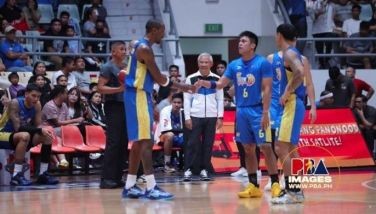We are a disaster waiting to happen

February 22, 2006 | 12:00am
Over the last weekend, I was watching ANC and intently listening to a government technocrat with the Mines and Geosciences Bureau as he explained why the landslide in Southern Leyte was not surprising. The technocrat who apparently has a PhD, proceeded to show a map of Leyte clearly marking the areas with high probability of landslides.
Guess what? That barrio of Guinsaugon in St. Bernard town in Southern Leyte was marked a high-risk area. In other words, it was a disaster waiting to happen. My question is, did the eggheads at the Mines and Geosciences Bureau warn the local government officials about it? If they did, did the LGU officials inform the residents in the area?
Assuming further that the residents were informed and they decided to take their chances, did the LGU come up with a contingency plan? A contingency plan would have something to say about continuous heavy rains and how this would make evacuation mandatory. Obviously, the LGU failed its constituents.
But I am not surprised. We, as a people, are too damn fatalistic. We always live dangerously, taking risks that could be avoided. If St. Bernard town is a major population center with large stakes in commerce and industry, it would be easy to understand the risk taking. High real estate values in some areas of Los Angeles county, made people there take the risk in similar landslide prone areas early last year. And like the residents of St. Bernard, they lost their bet with Mother Nature.
Because science has advanced quite a bit these days, the element of risk in situations like those landslides can be significantly reduced. This is why government must prioritize the completion of the task of mapping the entire country for precisely the probability of those risks. Geo-hazard maps provide information on potential areas where landslides, liquefaction, subsidence and other ground instabilities might occur, according to the website of the Mines and Geosciences Bureau.
In the long run, spending what is necessary to know the dangers we face is going to be cheaper than going through these heart rending search and rescue missions. Hopefully Ate Glue’s order to release funds for the mapping exercise is not just one of her press releases of the moment. My fear is, once we have recovered from this tragedy and life goes back to normal, we will forget the things we now know we should do.
I haven’t heard from my ex-boss, former Energy Minister Ronnie Velasco, for a long time. One time, when I was VP of News at ABS-CBN and he was invited as a guest in one of our programs, he studiedly ignored me even when he had to wait in my office to be called to the studio. Someone told me later he had a "hinanakit" with me, so I left it at that. For a Western-style no nonsense manager, he is terribly matampuhin.
Last year, he attended the reunion of former Petron/Energy Ministry/PNOC employees and I was surprised he asked a former SVP to invite me to join their table. We got to talking not just about old times but about how the current guys in the government’s energy bureaucracy seem to be clueless about the importance of their jobs.
The next time he called me was to ask me to read the first draft of his book, a sort of memoirs of his days as Energy Czar. It was interesting to read about the things we all did together in a time of crisis in energy some 20 years ago. It all seemed particularly relevant because another crisis of that sort is hovering over our present and our future.
Because the book was also about his management style, I wondered if managers like him went out of style. We can call Marcos the greatest creep that ever crept this country, specially on this 20th Anniversary of EDSA 1, but the quality of his cabinet is tops – from Cesar Virata, Paeng Salas, Bong Tanco, Bobby Ongpin, yes... even Juan Ponce Enrile and Ronnie Velasco. Politics aside, they delivered on their mandates. Today, the Cabinet members are lightweights, in comparison.
Ronnie Velasco is one excellent manager of people and resources. As I read the first draft of his manuscript, I remembered the sense of mission and professionalism he drilled into our subconscious. He only spoke to us once about an assignment and the next time he spoke to us about it, was to hear our report on what we have accomplished.
No ifs, no buts. If you value your job, the only acceptable report is one of success. The pressure was tremendous but those of us who reported directly to him, thrived masochistically on it. Twenty years after, the boss acknowledged in his memoirs that one of the secret factors of his success is the excellent staff he had in Petron and PNOC. Well, (ahem) that’s us!
His memoirs, to be launched tomorrow at the Nielsen Tower, recalls how we strategized and implemented an energy program designed to make us energy self reliant in a world energy environment that was more problematic than today, if only because the experience was totally new.
By the time he left government service in the wake of EDSA 1, we had put in place a pretty good program that had reduced our almost 100-percent dependency on foreign oil by half. We knew more about our domestic energy resources too... from oil to coal and, most particularly, geothermal. We have also done basic work on renewables like mapping the country for wind power, and pioneered studies on how to use biofuels like ethanol and coco diesel. We also tested the use of solar cells in remote barangays. We even had an expensive flirtation with nuclear power.
It was a pity that after EDSA 1, the Cory administration threw the energy plan we prepared into the trash heap. The country paid dearly for this act of political myopia. It didn’t take long for serious power blackouts to plague the economy in the late 80s and early 90s. If only they pursued the program we had evolved under Velasco, if only they built on it and given it the importance it deserved, maybe we wouldn’t have had the blackouts which were used by FVR as reason to sign all those IPP take or pay contracts that solved our emergency need for power but produced a glut and raised our power cost so much that it continues to hobble the economy today.
But I do not totally agree with everything my former boss wrote in his book. For instance, I take issue with his view that privatizing Petron is a mistake and selling down Napocor’s assets to the private sector is another mistake. The problem with Velasco is that he was Energy Czar during a martial law era, and he cannot imagine how an energy crisis can be effectively handled in a free market environment, with a freely elected Congress and with a free press.
Now 78 years old, Velasco must be reminded that times have changed and with globalization a continuing reality, privatizing Petron and Napocor is the only way to go. He says privatizing these energy assets reduces government’s ability to influence the energy market. I say, government today wouldn’t know how to use these assets anyway, to influence the energy market for the good of consumers. In fact, government would mismanage them so badly, as it continues to mismanage Napocor, to the detriment of the taxpayers. Government’s role today is simply to make sure the free market works.
I wonder if Velasco would have been as effective under today’s political environment. My guess is, not as effective as he had been under Marcos in a Martial Law regime, but because he is a world class manager, he would still do a lot better than the guys who have been trying to fill in his shoes all these years after EDSA.
Velasco’s book reads somewhat like an extended ego trip and may even seem defensive in parts for those who do not know Velasco well. But this failing can be forgiven if only because this book delivers an important message to current and future leaders that all it takes to handle the energy crisis is effective leadership. He did it in his time, there is no reason why we cannot do it now or in the years to come. We need an energy czar who knows his job the way Velasco did.
Here’s Dr. Ernie E.
Morris and Manuel were partners in a very successful garment manufacturing company. They were both having an affair with Beckie, a young attractive model who worked for their firm.
One day Beckie announced to her two lovers, "I’m pregnant!"
Since both partners were married men, they decided that Manuel would take Beckie to Mexico where she could have the baby without a scandal. Manuel took off for Mexico with Beckie while Morris ran the business and worried.
Several months later an e-mail arrived for Morris from Manuel. It read..." Dear Partner: Beckie had twins. Mine died at birth. What shall I do with yours?"
Boo Chanco’s e-mail address is [email protected]
Guess what? That barrio of Guinsaugon in St. Bernard town in Southern Leyte was marked a high-risk area. In other words, it was a disaster waiting to happen. My question is, did the eggheads at the Mines and Geosciences Bureau warn the local government officials about it? If they did, did the LGU officials inform the residents in the area?
Assuming further that the residents were informed and they decided to take their chances, did the LGU come up with a contingency plan? A contingency plan would have something to say about continuous heavy rains and how this would make evacuation mandatory. Obviously, the LGU failed its constituents.
But I am not surprised. We, as a people, are too damn fatalistic. We always live dangerously, taking risks that could be avoided. If St. Bernard town is a major population center with large stakes in commerce and industry, it would be easy to understand the risk taking. High real estate values in some areas of Los Angeles county, made people there take the risk in similar landslide prone areas early last year. And like the residents of St. Bernard, they lost their bet with Mother Nature.
Because science has advanced quite a bit these days, the element of risk in situations like those landslides can be significantly reduced. This is why government must prioritize the completion of the task of mapping the entire country for precisely the probability of those risks. Geo-hazard maps provide information on potential areas where landslides, liquefaction, subsidence and other ground instabilities might occur, according to the website of the Mines and Geosciences Bureau.
In the long run, spending what is necessary to know the dangers we face is going to be cheaper than going through these heart rending search and rescue missions. Hopefully Ate Glue’s order to release funds for the mapping exercise is not just one of her press releases of the moment. My fear is, once we have recovered from this tragedy and life goes back to normal, we will forget the things we now know we should do.
Last year, he attended the reunion of former Petron/Energy Ministry/PNOC employees and I was surprised he asked a former SVP to invite me to join their table. We got to talking not just about old times but about how the current guys in the government’s energy bureaucracy seem to be clueless about the importance of their jobs.
The next time he called me was to ask me to read the first draft of his book, a sort of memoirs of his days as Energy Czar. It was interesting to read about the things we all did together in a time of crisis in energy some 20 years ago. It all seemed particularly relevant because another crisis of that sort is hovering over our present and our future.
Because the book was also about his management style, I wondered if managers like him went out of style. We can call Marcos the greatest creep that ever crept this country, specially on this 20th Anniversary of EDSA 1, but the quality of his cabinet is tops – from Cesar Virata, Paeng Salas, Bong Tanco, Bobby Ongpin, yes... even Juan Ponce Enrile and Ronnie Velasco. Politics aside, they delivered on their mandates. Today, the Cabinet members are lightweights, in comparison.
Ronnie Velasco is one excellent manager of people and resources. As I read the first draft of his manuscript, I remembered the sense of mission and professionalism he drilled into our subconscious. He only spoke to us once about an assignment and the next time he spoke to us about it, was to hear our report on what we have accomplished.
No ifs, no buts. If you value your job, the only acceptable report is one of success. The pressure was tremendous but those of us who reported directly to him, thrived masochistically on it. Twenty years after, the boss acknowledged in his memoirs that one of the secret factors of his success is the excellent staff he had in Petron and PNOC. Well, (ahem) that’s us!
His memoirs, to be launched tomorrow at the Nielsen Tower, recalls how we strategized and implemented an energy program designed to make us energy self reliant in a world energy environment that was more problematic than today, if only because the experience was totally new.
By the time he left government service in the wake of EDSA 1, we had put in place a pretty good program that had reduced our almost 100-percent dependency on foreign oil by half. We knew more about our domestic energy resources too... from oil to coal and, most particularly, geothermal. We have also done basic work on renewables like mapping the country for wind power, and pioneered studies on how to use biofuels like ethanol and coco diesel. We also tested the use of solar cells in remote barangays. We even had an expensive flirtation with nuclear power.
It was a pity that after EDSA 1, the Cory administration threw the energy plan we prepared into the trash heap. The country paid dearly for this act of political myopia. It didn’t take long for serious power blackouts to plague the economy in the late 80s and early 90s. If only they pursued the program we had evolved under Velasco, if only they built on it and given it the importance it deserved, maybe we wouldn’t have had the blackouts which were used by FVR as reason to sign all those IPP take or pay contracts that solved our emergency need for power but produced a glut and raised our power cost so much that it continues to hobble the economy today.
But I do not totally agree with everything my former boss wrote in his book. For instance, I take issue with his view that privatizing Petron is a mistake and selling down Napocor’s assets to the private sector is another mistake. The problem with Velasco is that he was Energy Czar during a martial law era, and he cannot imagine how an energy crisis can be effectively handled in a free market environment, with a freely elected Congress and with a free press.
Now 78 years old, Velasco must be reminded that times have changed and with globalization a continuing reality, privatizing Petron and Napocor is the only way to go. He says privatizing these energy assets reduces government’s ability to influence the energy market. I say, government today wouldn’t know how to use these assets anyway, to influence the energy market for the good of consumers. In fact, government would mismanage them so badly, as it continues to mismanage Napocor, to the detriment of the taxpayers. Government’s role today is simply to make sure the free market works.
I wonder if Velasco would have been as effective under today’s political environment. My guess is, not as effective as he had been under Marcos in a Martial Law regime, but because he is a world class manager, he would still do a lot better than the guys who have been trying to fill in his shoes all these years after EDSA.
Velasco’s book reads somewhat like an extended ego trip and may even seem defensive in parts for those who do not know Velasco well. But this failing can be forgiven if only because this book delivers an important message to current and future leaders that all it takes to handle the energy crisis is effective leadership. He did it in his time, there is no reason why we cannot do it now or in the years to come. We need an energy czar who knows his job the way Velasco did.
Morris and Manuel were partners in a very successful garment manufacturing company. They were both having an affair with Beckie, a young attractive model who worked for their firm.
One day Beckie announced to her two lovers, "I’m pregnant!"
Since both partners were married men, they decided that Manuel would take Beckie to Mexico where she could have the baby without a scandal. Manuel took off for Mexico with Beckie while Morris ran the business and worried.
Several months later an e-mail arrived for Morris from Manuel. It read..." Dear Partner: Beckie had twins. Mine died at birth. What shall I do with yours?"
Boo Chanco’s e-mail address is [email protected]
BrandSpace Articles
<
>
- Latest
- Trending
Trending
Latest
Trending
Latest
Recommended






























